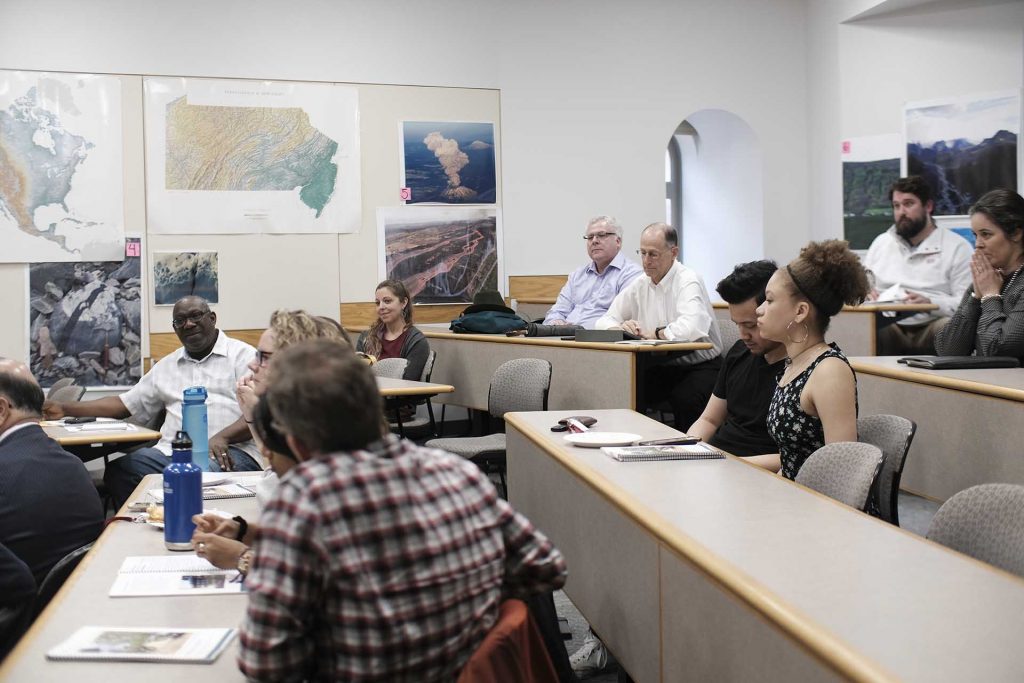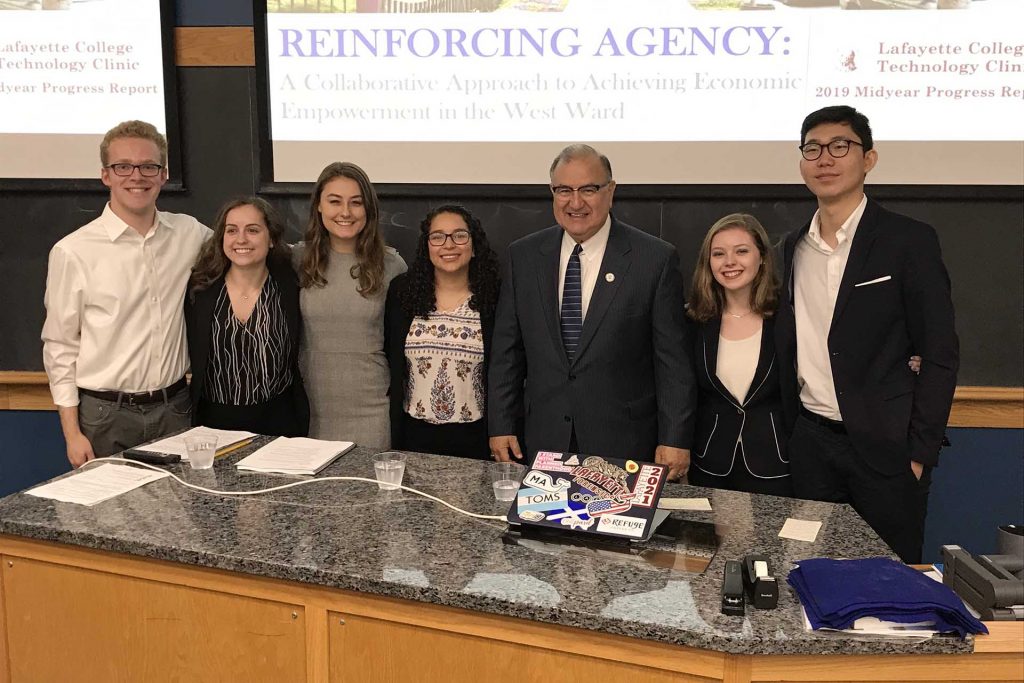Technology Clinic students begin five-year plan to empower Easton’s West Ward residents
By Stephen Wilson
Nearly 10,000 people living within 1 square mile. The majority are younger than 43 years of age, two-thirds of whom are in rental properties. About 6% are high school dropouts. And the median household income is roughly $35,000.
By the numbers, Easton’s West Ward residents seem like an underdog: young and struggling but not giving up.
Focusing on people and looking positively at the neighborhood’s assets is the approach of a five-year Technology Clinic project that kicked off in January.
Mentored in their work by Lawrence Malinconico, associate professor of geology and director of Technology Clinic, and Gladstone “Fluney” Hutchinson, associate professor of economics and director of Economic Empowerment and Global Learning Project, the students from various disciplines used a quote to help frame their work this semester from Abu Rizvi, professor of economics and then provost: “Freedom means that individuals are able to determine the sorts of lives they lead rather than having their lives determined for them.”
 Agency, allowing individuals to make their own choices, was the driving goal.
Agency, allowing individuals to make their own choices, was the driving goal.
“We want to assume a human-centric approach,” says Aidan Wood ’21. “Economic empowerment is only possible if they are at the forefront of this collaboration.”
Collaborators include the City of Easton and Greater Easton Development Partnership, which recently launched a West Ward Community Initiative that will infuse $1.2 million in state tax credit and corporate partnership dollars into various improvements.
Tech Clinic students took to the streets, talking to residents, meeting business owners, engaging stakeholders, and attending events. They also dove into the numbers, studying history, demographic data, and economic theory.
They began to map out assets—physical and intangible facets that are full of potential or valued by the community. The team identified several including location, affordable housing, racial and ethnic diversity, and businesses/organizations.
“It’s important for residents to achieve strengthened voice, empowerment, agency, and capacity for personal economic and social development,” says Hutchinson. “We hope collaborating with the students that residents will find ways to commoditize community assets for inclusive and shared community wealth creation and economic development.”
Students saw those community assets as opportunities—areas that require true collaboration in order to help residents flourish including:
- Increasing home ownership
- Creating community bonds and engagement through art, food, cultural celebrations, music, and outdoor activities
- Continuous access to career development resources
- Engaging youth through peer-to-peer relationships and after-school programming
- Igniting and supporting entrepreneurship
- Easy access to fresh produce
 Sal Panto, Easton mayor, and Jared Mast ’04, executive director of GEDP, were both on hand to ask questions, offer feedback, and praise the effort.
Sal Panto, Easton mayor, and Jared Mast ’04, executive director of GEDP, were both on hand to ask questions, offer feedback, and praise the effort.
“Residents, when armed with improved empowerment and agency, can redesign assets and relationships for their personal and community benefit,” says Malinconico. “The lessons from this project could potentially offer valuable insights to community development efforts in post-industrial cities across America. These lessons could more importantly improve society’s understanding of how individuals having greater freedom and responsibilities are able to, paraphrasing Rizvi, determine the sort of lives they’d like to lead.”
Read the full mid-project report.

Mayor Sal Panto poses with the team: Aidan Wood ’21, Paige Beede ’20, Rachel Cox ’21, Geraldine Agredo ’20, Luisa Gunn ’21, and Tergel Khatanbaatar ’21.
 Agency, allowing individuals to make their own choices, was the driving goal.
Agency, allowing individuals to make their own choices, was the driving goal. Sal Panto, Easton mayor, and
Sal Panto, Easton mayor, and 
3 Comments
I grew up in the West Ward at 928 Lehigh Street and commuted from there to Lafayette from SEP ’65 to my graduation in JUN ’69
My Grandfather Luther A Flowers (Instructor in Forge Work 1915 to 1917) lived at 732 Washington Street and my other Grand Father Wilson R Erb who did work on the replica of the Marquis residence lived at 8th & Spruce Street. It is great to see the effort to help the West Ward
What a great project. I am heartened to see college-age students engaged in such an important and fundamental need in our society. I only just last year became personally involved in trying to find paths to affordable rents and mortgage costs for the ordinary working and retired people in the San Francisco Bay Area. Adequate and affordable housing is the beginning of equal opportunity in jobs, education, safe neighborhoods and the like. Just learning that will help these students become changemakers as they move into full adulthood.
The Technology Clinic in general and this project in particular are terrific developments! Synthesis of learning across disciplines and practical application in a real-world setting provide an exponential enhancement to the classroom experience. Working outside the classroom with faculty mentors on real problems was the best part of my Lafayette experience (many years ago). I only hope that there is enough diversity of thought on the project team to constantly challenge assumptions and demand data to back up assertions and conclusions that are being advanced. Never underestimate the value of the loyal opposition!
Comments are closed.